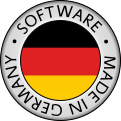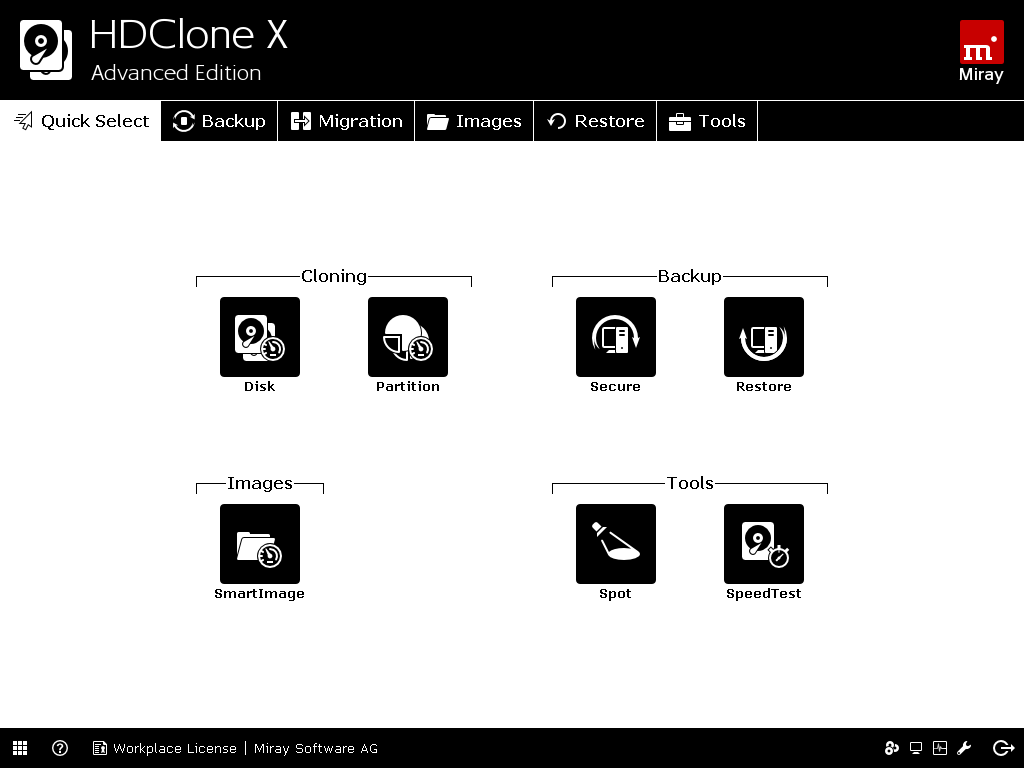HDClone X.5
Advanced Edition
For semi-professional use. Power users and professionals benefit from the maximum of performance and efficiency of the Advanced Edition when cloning disks and creating backups and images.
new: Reworked CopyEngine: never been faster
HDClone’s CopyEngine, the underlying copying algorithm, has been completely reworked from ground up—and while HDClone’s engine has always been performing in the top range, we further improved it with special attention to SSDs, having achieved a 65% increase in performance for single copies on fast SSDs with HDClone.
Full Speed
HDClone maxes out your hardware’s speed limits. In a best case scenario our FastCopy algorithm doubles cloning speed—and using logical images with SmartCopy it gets even faster. The TRIM command not only accelerates your SSD while cloning, but also improves reading times afterwards.
new: SmartCopy for Apple HDDs
HDClone’s SmartCopy mode, allowing you to skip the unused areas of the source disk when copying, now supports the Apple filesystem HFS+, thus offering the high SmartCopy performance and the features known from FAT/NTFS—upsizing, downsizing and on the fly defragmentation—for Apple hard disks.
new: Smaller images with differential backups
After creating a regular image HDClone now allows you to create differential backups of future changes. By only copying actual changes, these backups will be a lot smaller in size.
Don’t worry about managing these backups: because a differential backup always refers to the same original image, you can sort out unnecessary backups just by deleting them – the other differential backups will still work!
Compressed and password-protected images
HDClone creates images—optionally with compression and/or password protection.
In addition you can mount an image in Windows using our software Miray Virtual Disk (included).
USB devices
Clone from and onto USB devices, like key drives and card readers—on Windows as well as in the self-booting version.
new: Bluetooth input devices in self-booting mode
new: Windows 11 support
HDClone supports all Windows versions from XP—including the new Windows 11.
Self-booting and on Windows
HDClone offers a self-booting version (HDClone/S) and a Windows application (HDClone/W). Both versions use the same user interface, so switching between the two is no problem.
Volume Licenses
If you need HDClone for the staff of your organization, please consider our Volume License.
Features
- New: Reworked CopyEngine
- New: Differential images
- Accelerated SSDs via TRIM
- Advanced Format drive cloning & backup
- PartitionSelect
- New: Boot from SecureBoot and with Bluetooth mice/keyboards
- Self-booting and under Windows
- QuickCompress—fast image compression
- Password protected images
- UEFI and GPT support
- Miray Virtual Disk: write to virtual drives (also VHDX/VDI)
- New: SmartCopy, up-/downsizing and defrag for HFS+
- SmartCopy: logical copies
- SafeRescue mode for data recovery
- Automatic upsizing of NTFS/FAT/ext2–4/HFS+ partitions
- Automatic downsizing of NTFS/FAT/HFS+ partitions
- Defrag on the fly for HFS+, NTFS and FAT
- HotCopy & LiveImage during Windows operation
New: Reworked CopyEngine
HDClone has never been faster—especially for SSDs
HDClone’s CopyEngine, the actual copying algorithm, has been completely reworked from ground up. Already ranking in the top range of performance, the CopyEngine has been improved with special attention to SSDs and we managed to achieve an up to 65% improvement in performance for single copies of fast SSDs. Already balancing the load excellently, the improvment for multi copies is slightly lower: The 8% improvment in performance is nonetheless remarkable.
New: Differential Images
Saves Images as changes to the original image
This features allows you to save the changes done to a original backup, creating differential backup images with typically significantly lower file sizes. Similar to incremental backups of other applications, HDClone’s differential backups have the advantage of being independent of each other, allowing you to selectively delete them. Consider this examplary scenario: You can create daily differential backups and delete six of seven backups every week, keeping a backup for each week. In addition there is no performance difference when restoring different differential backups
Intel Software RAID Support
Supports Intel Matrix Storage modes 0, 1, 10 and 5
HDClone can access Intel Software RAIDs (also known as Intel Matrix Storage) in modes 0, 1, 10 and 5 in the self-booting version (HDClone/S). Intel Software RAIDs can be used just like regular hardware RAID systems.
Accelerated SSDs with TRIM
Faster reading and writing through TRIM
TRIM commands are used by HDClone to tell the SSD which disk areas are no longer needed. In addition to higher copying speed the SSD gains its original performance afterwards, resulting in higher reading and writing speed.
Advanced Format
Support for modern sector sizes
For over 30 years, 512 Bytes have been the one-and-only standard sector size for any PC mass storage media. Now modern drives in “Advanced Format” can have different sector sizes (512, 512e, 1Kn, and 4Kn). HDClone allows you to create clones and file images between disks with different sector formats and converts NTFS and FAT file systems automatically.
PartitionSelect
Selective cloning
Allows to select one or more partitions of a disk to be transferred without having to copy all the partitions. This saves space on the target drive, making it possible to use a smaller target or using the additional space for the remaining partitions. The special thing about PartitionSelect is that it transfers the required data in one single step, no matter what size the partitions have or how they are arranged. Copying the partitions, plus other adjustments will be performed with almost no extra time required and HDClone will still work at its maximum speed.
Self-booting (new: Bluetooth, SecureBoot) and Windows
HDClone works without an operating system
HDClone can be booted from CD/DVD and USB stick, even on SecureBoot systems, so you even can recover an image without a working operating system. With identical interfaces on both programs there is complete ease in switching between the self-booting version and the Windows program and supports USB and Bluetooth mice and keyboards.
File images
Optional compression and password protection
Instead of a direct copy from medium to medium, you can also store an exact image of the medium in a file image. Optionally, the image may be created compressed or password protected. With QuickCompress enabled, this requires almost no extra time for compressing. These file images can be stored, archived, or transmitted via network and the Internet. They can be restored 1:1 to a medium which then behaves just like a direct copy had been made.
Miray Virtual Disk
Direct access to file images
From the Basic Edition on, HDClone includes the software Miray Virtual Disk. You can use this software to mount file images that have been created with HDClone as virtual Windows drives. This allows you to access files and folders in an image directly without having to restore the image to a physical disk before.
UEFI and GPT Support
Supports UEFI BIOS and GUID partition tables
This feature allows HDClone to run on computers with new UEFI BIOS. GPT partitions used for large (> 2 TB) hard disks are recognized automatically and copied correctly.
Faster with SmartCopy Mode (new: HFS+)
Faster data transfer and shorter copying times
HDClone creates logical sector copies (SmartCopy) of FAT, NTFS, HFS+ and ext2/ext3/ext4 file systems in only a fraction of the time usually needed—yielding an equivalent result. SmartCopy can clone an entire Windows XP base installation in less than 20 seconds for example.
Upsizing on the Fly (new: HFS+)
Adjusting the file system to a bigger target on the fly
HDClone can increase your FAT, NTFS, HFS+ and ext2/ext3/ext4 partition size automatically on the fly during copying.
Downsizing on the Fly (new: HFS+)
Adjusting the file system to smaller targets on the fly
HDClone can decrease your NTFS, FAT and HFS+ partition size automatically on the fly during copying. This allows you to adjust partition sizes during cloning or to migrate to smaller media. Perfect for migrating to (usually smaller) SSD drives.
Defragmentation on the fly (new: HFS+)
Make NTFS, FAT and HFS+ partitions faster while copying
HDClone can perform a perfect defragmentation on NTFS, FAT and HFS+ volumes while copying or restoring from a file image. This defragmentation only needs a fraction of the time usually required, consuming almost no additional time compared to the copying process.
HotCopy & LiveImage
Copies and backup during operation
HDClone now can create copies and file images of drives and partitions during Windows operation - even for the system volume.
Safe Data Recovery
Read defective media in SafeRescue mode
When copying from media with defective areas these areas will be skipped in the first run. The rescue operation will be performed at the end of the process to prevent further disk damage.
License options
HDClone Advanced Edition may be obtained as Workplace License (Online Shop) as well as Volume License (Online Shop or on request).
Workplace License
A Workplace License allows the licensee to permanently install and use1 the product on up to two PCs, typically a PC and a notebook.
Volume License
A volume license allows the licensee to permanently install and use1 the product on multiple PCs, where the maximum number corresponds to the volume agreement2.
- 1
- For temporary licenses this only applies within the corresponding period. The period can be extended after termination.
- 2
- The volume is determined upon purchase.
Operating systems
Self-booting (HDClone/S)
- 586 processor or higher
- 256 MB RAM
- VGA graphics
- bootable CD/DVD or USB drive
- UEFI is supported
Windows program (HDClone/W)
See the hardware requirements of your Windows version (XP onwards). Does not run on Windows Server.
Supported Controllers
| Controller type | self-booting | on Windows |
|---|---|---|
| PCI-IDE/ATA hard disk controller | yes | yes |
| Busmaster IDE controller | yes | yes |
| USB 1.1 (UHCI, OHCI) | yes | yes |
| USB 2.0 (EHCI) | yes | yes |
| USB 3.0 (XHCI) | yes | yes |
| AHCI (SATA II) controller | yes | yes |
| Firewire/IEEE1394 (OHCI) | no | no |
| Adaptec SCSI host adapter* | no | no |
| Other SCSI host adapter (LSI, …) | no | no |
| SAS host adapter | no | no |
| RAID controller | no | no |
- *
- A complete list of Adaptec SCSI host adapters supported by HDClone/S is to be found here.
Supported Media
| Media type | self-booting | on Windows |
|---|---|---|
| USB key drives | yes | yes |
| IDE, ATA, SATA, eSATA | yes | yes |
| USB | yes | yes |
| Firewire, SCSI | no | no |
| SSD | yes | yes |
| SAS | no | no |
| CompactFlash | yes | yes |
| SD, MMC | yes | yes |
| xD and others | yes | yes |
Supported file systems
| Mode | self-booting | on Windows |
|---|---|---|
| Copy | any | any |
| SmartCopy | NTFS, FAT, HFS+, ext2–4 | NTFS, FAT, HFS+, ext2–4 |
| Image | any | any |
| SmartImage | NTFS, FAT, HFS+, ext2–4 | NTFS, HFS+, FAT, ext2–4 |
| Up-sizing | NTFS, FAT, HFS+, ext2–4 | NTFS, FAT, HFS+, ext2–4 |
| Down-sizing | NTFS, FAT, HFS+ | NTFS, FAT, HFS+ |
| Defrag | NTFS, FAT, HFS+ | NTFS, FAT, HFS+ |
| Image target* | NTFS, FAT | any |
- *
- Image files need to be stored to certain file systems (on Windows, any supported file system may be used).

Updates & Upgrades










